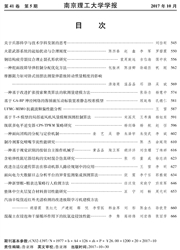

 中文摘要:
中文摘要:
为了提高某客车在正面碰撞过程中的安全性,参照我国CMVDR294法规,采用有限元法建立了该大型客车前碰撞有限元仿真模型。针对其安全性不足的问题,提出对车身骨架结构进行改进设计,并在车身前端安装"田"字形吸能结构。考虑到设计制造过程中的误差会影响客车碰撞安全的可靠性,将有限元法与试验设计、响应面法结合起来对"田"字形吸能结构进行可靠性优化设计,并分析了与确定性优化设计所得结果的差别。结果表明,对车身骨架结构进行改进设计,在车身前端安装"田"字形吸能结构能显著提升客车在正面碰撞过程中的安全性,且可靠性优化设计与确定性优化设计都能进一步提高其正面碰撞安全性能;而当设计变量取值发生变动时,可靠性优化设计使吸能量的可靠度从原来的64.5%提高到了97.8%,更好地满足了大型客车碰撞安全性的要求。
 英文摘要:
英文摘要:
In order to improve the safety of a bus in the process of frontal impact,with reference to chinese CMVDR294 laws and regulations,the finite element method is adopted to establish the finite element simulation model for the large-scale bus frontal collision. In allusion to the problem of the lack of security,it is proposed to improve the body frame structure design,and to install "田"-shaped energy-absorbing devices in the front bus body. Considering the design and manufacture error will affect the reliability of the bus crash safety,the finite element method,experiment design and response surface method are combined to carry out the reliability optimization design of the "田"-shaped energy-absorbing structure,and the difference between the results of this design and deterministic optimization design is analysed. The result shows that( 1) for the modification design of body frame structure,to install"田"-shaped energy-absorbing structure in the front car body can significantly improve the bus safety in the process of frontal impact,both reliability optimal design and deterministic optimal design can improve the frontal impact safety performance;( 2) when designing variable values change,the reliability optimal design makes the reliability of energy absorption increased from64. 5% to 97. 8%,it can better meet the requirements of the bus crash safety.
 同期刊论文项目
同期刊论文项目
 同项目期刊论文
同项目期刊论文
 期刊信息
期刊信息
